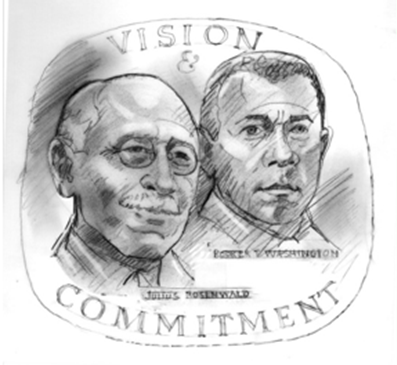 |  |
Plaque designed by Eugene Daub, produced by Jim Licaretz, unique bonded bronze.
Portraits, Julius RoseMedal designed by Eugene Daub, produced by Jim Licaretz in bonded bronze. Maximum of 100 medals made. Portraits, Julius Rosenwald and Booker T. Washington, VISION & COMMITMENT. Reverse: two seated students, ROSENWALD SCHOOLS/ MORE THAN 5,000 BUILT 1913-1937, D A U B. 3 1/2 inches.nwald and Booker T. Washington, DAUB, approx. 10 inches.
No medals made.
A child of Jewish German immigrants, Rosenwald dropped out of high school after two years to apprentice with his uncles, who were major clothing manufacturers in New York City. By his 30th birthday he had achieved moderate success running his own business that made ready-to-wear men’s suits. Then came his big break – when he bought a quarter of the Sears, Roebuck company. Sears was the Amazon.com of its day. Rosenwald put 7,000 laborers to work day and night building a huge warehouse. Special machines were made that could open letters at the rate of 27,000 per hour. A system of conveyor belts, pneumatic tubes, and color-coded tags shunted merchandise through the vast new plant. Henry Ford reportedly visited and absorbed ideas for his future assembly line. Management expert Peter Drucker later characterized Rosenwald as “the father . . . of the distribution revolution which has changed the world economy in the twentieth century and which is so vital a factor in economic growth.” By the end of 1908, Rosenwald was its president and a multimillionaire. With the company on an even keel, his attention turned rapidly toward philanthropy. Soon he was giving away money with at least as much gusto as he poured into earning it.
During the summer of 1910, Rosenwald read the autobiography of the great black educator Booker T. Washington, and was strongly affected. Within a year, Rosenwald and Washington were building a relationship that included visits to each other’s homes.

Example of a Rosenwald School
In 1912, Rosenwald celebrated his 50th birthday by giving away close to $700,000 (about $16 million in current dollars), including $25,000 to Washington’s Tuskegee Institute. Washington shrewdly set aside part of it to launch a new experiment which he expected might interest his donor—a $2,100 effort to build new schools in parts of Alabama where little or no education was being offered to rural blacks. Soon Rosenwald and Washington were ramping up their program, eventually building schools all across the South over more than 20 years. There were correlated efforts to train teachers to serve in the new schools, and funds to provide libraries and workshops for students. By 1932, the year Julius died, an astonishing 4,977 Rosenwald schools, and 380 complementary buildings, had been erected in every Southern locale with a significant black population. Fully 35 percent of all black children in the South (and 27 percent of black children period) were educated that year in a Rosenwald school.
In the school-building program, he insisted right from the beginning that his donation would only be made if it was matched by local residents (most of whom were poor blacks who skeptics said could never come up with adequate funds). He also craftily maneuvered local and state governments into participating, overcoming their historical dismissal of black education with the lure of outside manna. Local whites also contributed, encouraged by the uplift the new schools offered their towns.
Julius Rosenwald left a powerful imprint on numerous causes. He brought the inspirational science and technology museum to America by single-handedly funding the Museum of Science and Industry in Chicago. He gave many millions to Jewish interests, including saving thousands of victims of the Russian Revolution. He was a generous backer of black colleges. He funded the construction of 22 YMCA/YWCA community centers and urban dormitories for blacks during the segregated era. And he funded a third of the litigation costs of the Brown v. Board of Education case that ended school segregation. He was for many years also the largest donor to the University of Chicago, located within a mile of his home, and spawned its medical school among many other worthy intellectual projects. In current dollars, Rosenwald’s total donations amounted to something under $2 billion.
Rosenwald changed philanthropy. Together, the combination of the lives he directly transformed, and his many innovations in the practice and execution of giving which inspired other wealthy individuals to become more effective givers, set him apart. That he is largely unknown — thanks to his principles like keeping his name off projects and limiting the life of his foundation — is only a further tribute to his good motives.
Extracted from an article in the Philanthropy Hall of Fame on www.PhilanthropyRoundtable.org